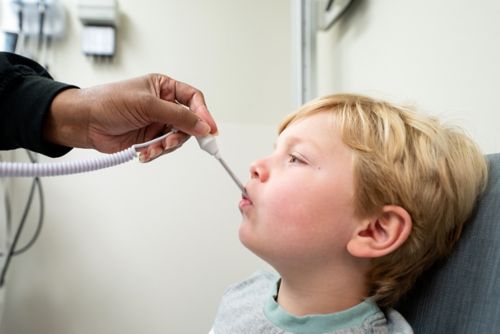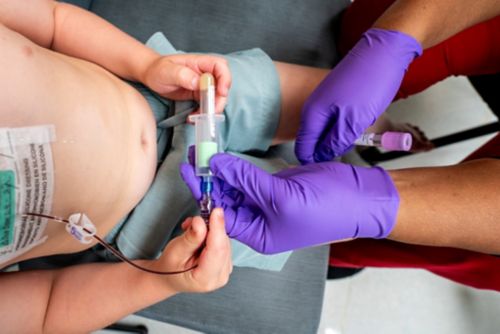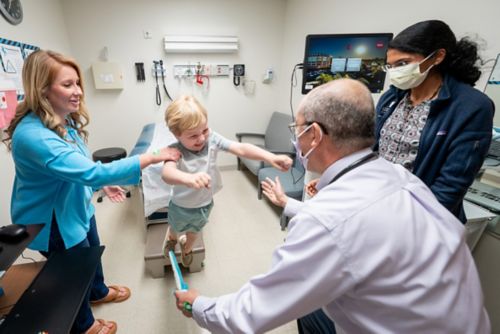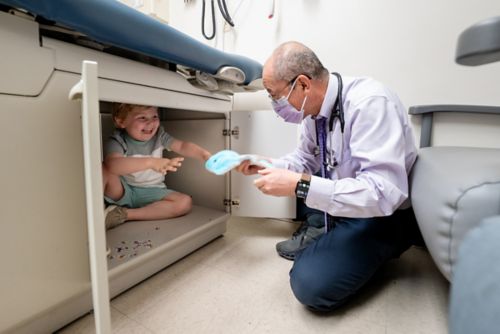St. Jude Family of Websites
Explore our cutting edge research, world-class patient care, career opportunities and more.
St. Jude Children's Research Hospital Home

- Fundraising
St. Jude Family of Websites
Explore our cutting edge research, world-class patient care, career opportunities and more.
St. Jude Children's Research Hospital Home

- Fundraising
St. Jude was established in 1962, in part to tackle the daunting task of improving childhood cancer survival, which was just 4%.
Today, with treatment protocols innovated at St. Jude, the five-year survival of the most common pediatric cancer, acute lymphoblastic leukemia (ALL), exceeds 90% in the United States. However, more work remains.
Our scientists are now putting every facet of the rarest and most treatment-resistant leukemia subtypes under the lens to find even the subtlest vulnerabilities and opportunities to improve outcomes for the remaining 10% of pediatric ALL cases.
Scrutinizing B-cell ALL to predict relapse
“ALL treatment is a great success story, but there remains a population of children whose disease is not fully cured,” said Charles Mullighan, MBBS (Hons), MSc, MD, Department of Pathology.
Mullighan co-led a study published in the Journal of Clinical Oncology that addresses the differences in survival among children with standard-risk B-cell ALL (SR B-ALL) by identifying the genetic predictors of relapse. SR B-ALL is the most common form of pediatric ALL, and as such, nearly half of all relapsed pediatric ALL cases are SR B-ALL. Survival among patients with relapsed or resistant B-ALL falls between 30% and 50%, indicating a dire need for a better understanding of this subgroup.

ALL treatment is a great success story, but there remains a population of children whose disease is not fully cured.
Department of Pathology
The scientists conducted whole-genome and -transcriptome sequencing on SR B-ALL samples and compared data from patients who experienced relapse with patients who remained in complete remission. They found that B-ALL subtypes, genetic alterations, and patterns of aneuploidy (extra or missing chromosomes) were associated with the risk of and time to relapse. Some B-ALL subtypes, such as hyperdiploid ALL and ETV6::RUNX1 ALL, had a low frequency of relapse, but others, including PAX5-altered, TCF3/4::HLF, ETV6::RUNX1-like, and BCR::ABL1-like ALL, were associated with an increased risk of relapse.
Based on these results, Mullighan suggested, “Children with SR B-ALL should have their tumor cell genome sequenced upon their initial diagnosis to identify if their tumor cells have these high-risk features so that their initial therapy intensity can be increased.”

A St. Jude patient enrolled in St. Jude Total Therapy XVI clinical trial waits for an appointment in a waiting room.
Higher resolution of gene expression reveals vulnerability in treatment-resistant B-ALL
Understanding the biology of drug resistance in cancer is one of the top research priorities for St. Jude scientists. In Cancer Cell, Jun J. Yang, PhD, Department of Pharmacy & Pharmaceutical Sciences vice-chair, and colleagues reported which B-ALL cells resist treatment and why, as well as a potential counter approach.
“We found a new explanation of B-ALL sensitivity to asparaginase, a drug commonly used for this disease,” said senior co-corresponding author Yang.
“We found leukemic B cells are stuck in two major stages,” said co-corresponding author Jiyang Yu, PhD, Department of Computational Biology interim chair, whose lab investigated gene expression from thousands of cancerous B cells. “One is an earlier stage that is more resistant to asparaginase and another later stage that is more sensitive to it.”


A St. Jude patient attends a checkup appointment with Hiroto Inaba, MD, PhD, Department of Oncology, who finds some time to have fun with him too.


Find out more about Micah, the patient pictured above, and his experience in the Total Therapy XVII clinical trial
Leveraging single-cell network analysis and drug-sensitivity profiling, Yu and his colleagues discovered that treatment-resistant cancer cells exploit the cell death protein BCL-2 to evade self-destruction. The protein is also downstream of mTOR, asparaginase’s target. This resistance mechanism prompted the scientists to investigate the therapeutic usefulness of venetoclax, a BCL-2 inhibitor. They showed that combining asparaginase with venetoclax was more effective than either drug alone in laboratory models of three high-risk B-ALL subtypes.
“Administering asparaginase alongside venetoclax may reduce the risk of ALL relapse, which is the leading cause of treatment failure,” said co-author Ching-Hon Pui, MD, Department of Oncology. “These findings merit further investigation in future clinical trials.”
Reducing the intensity of B-ALL treatment
“We strive to be mindful, using only the necessary treatments to achieve a cure, so that we can minimize the risk of enduring side effects from a child’s cancer treatment,” said Katelyn Purvis, MD, a pediatric hematology-oncology fellow in the Department of Oncology and first author on a clinical trial study published in Blood designed to determine whether certain B-ALL subtypes can be cured with lower-intensity treatments.
Results showed that patients with ETV6::RUNX1 and high-hyperdiploid B-ALL, which, according to the National Cancer Institute risk assessment, would receive a high-intensity treatment regimen, can be treated with a low-intensity regimen and still have positive outcomes.

We incorporated genetic information and response criteria into our risk assessment. This risk classification system allows us to identify patients who can be treated with lower-intensity therapies while ensuring those who require more intensive treatment receive it
Department of Oncology
“In the St. Jude Total Therapy XV and XVI studies, we incorporated genetic information and response criteria into our risk assessment. This risk classification system allows us to identify patients who can be treated with lower-intensity therapies while ensuring those who require more intensive treatment receive it,” said corresponding author Hiroto Inaba, MD, PhD, Department of Oncology.
Patients who would have otherwise received high-risk therapy experienced fewer side effects, such as thrombosis and pancreatitis. The findings suggest that clinicians can accurately identify patients likely to benefit from less intensive treatment by using genome- and early treatment response–guided risk classification.

A St. Jude scientist looks at pathology slides for pediatric acute myeloid leukemia (pAML)
Focusing on single nucleotides in DNA to predict and treat disease
While much research focuses on understanding B-ALL genetics after diagnosis, scientists can apply the same techniques to predict if a child is at a higher risk of cancer before it develops. In a study published in Blood, St. Jude researchers characterized variants in a single gene in children with B-ALL to determine which were risk factors for the disease.
“We found NBN is a key B-ALL risk gene,” Yang, the corresponding author, said. “We identified many genetic variants in this gene that seemed to be linked to B-ALL, and we meticulously characterized their functional consequences.”

We found NBN is a key B-ALL risk gene [and] identified many genetic variants in this gene that seemed to be linked to B-ALL, [then] we meticulously characterized their functional consequences.
Department of Pharmacy and Pharmaceutical Sciences
The researchers sequenced NBN in 4325 patients with B-ALL and found 25 unique, putatively damaging coding variants in 50 patients. These variants were overrepresented in children with this form of leukemia, suggesting that they predispose people to the disease.
Testing these variants in the lab, the scientists found that 14 variants caused severe loss of function of the protein encoded by NBN. NBN is involved in double-stranded DNA repair, so the loss of its activity provides a plausible mechanism for increased cancer incidence. However, NBN loss also represents a potential challenge for treating leukemia.
“As NBN is involved in DNA repair and many leukemia drugs cause DNA damage, we did worry that patients with variants would experience higher treatment-related toxicity,” Yang said. “But that did not seem to be the case, although the number of patients we studied was relatively small.” The researchers found that the survival of these patients was comparable to that of patients without NBN variants, suggesting that patients with NBN variants can safely receive standard B-ALL care and experience a reasonable treatment outcome.
Fine-tuning treatment for T-cell ALL
Childhood T-cell ALL (T-ALL) is an aggressive cancer that typically responds well to initial treatment, but relapsed T-ALL and treatment-resistant disease have dismal prognoses. Given its relative rarity, studying T-ALL genetics has been difficult. To address that need, St. Jude collaborated with other pediatric research hospitals to profile the whole germline and cancer genomes of more than 1300 children, adolescents, and young adults with T-ALL.

A St. Jude scientist loads a gel.
As published in Nature, T-ALL was classified into 15 subtypes with distinct gene expression and genomic drivers, including previously undefined subtypes. The researchers also refined the classification of known subtypes and showed that driver lesions, other genetic changes, and the original cell type cooperate to define the genomic subtype and a condition’s clinical and biological characteristics. They also observed a significant link between the kind of gene alterations and outcomes in T-ALL.
The study found that approximately 60% of the genetic changes driving T-ALL cells are noncoding changes. “It was striking how abundant these noncoding changes were and how many of them were enhancer-perturbation events,” Mullighan, a co-corresponding author, said. “We now have a much stronger framework to take these alterations back to the lab, build the right models to understand the biology, and test therapy.”
Focusing on the rarest T-ALL subtypes
Investigators from St. Jude and an international collaborative group of more than 50 researchers joined forces to understand the rare but aggressive gamma delta T-cell ALL (γδ T-ALL). In Cancer Discovery, they reported identifying 200 children with γδ T-ALL, the largest cohort of the disease.
“We needed a large collaborative effort to understand the genetics in these cases to figure out how to potentially treat them,” co-corresponding author Inaba said.
The researchers found that genetic alterations resulting in activation of LMO2, a gene commonly altered in other types of T-ALL, and inactivation of STAG2, a gene more commonly altered in acute myeloid leukemia (AML) and solid tumors, were associated with worse outcomes.
“This alteration switches STAG2 off, taking the STAG2 promoter and moving it proximal to LMO2, switching it on,” Mullighan, a co-corresponding author, said. “This dual mechanism is unusual and provides insight into what happens at the genomic level in this rare cancer.”
That insight also highlighted potential treatment strategies, informing drug-screening design to identify therapeutics that may help treat γδ T-ALL. PARP inhibitors, which target dysfunctional DNA-repair pathways in cancer cells, showed some promise. STAG2 is an important protein that acts as a subunit of the cohesin complex, which stabilizes DNA replication forks and helps maintain chromosomes. When STAG2 is mutated, double-stranded DNA breaks become more common. PARP inhibitors could plausibly target STAG2’s functional defect, accelerating DNA damage accumulation and driving cancer cells toward self-destruction.
Inaba expressed optimism about PARP inhibitors, “This is very exciting to identify a potential targeted therapy for these patients who have typically poor outcomes.”
Taking a microscope to pediatric AML
Despite constituting only 20% of pediatric acute leukemias, pediatric acute myeloid leukemia (pAML) remains the leading cause of mortality among children with leukemia. However, “most of what we know about classifications of AML comes from the adult field,” said Jeffery Klco, MD, PhD, Department of Pathology, who led a study published in Nature Genetics to define the molecular underpinnings of pAML. “Many of the AML types we see here at St. Jude, you just don’t see in adults.”

Most of what we know about classifications of AML comes from the adult field. Many of the AML types we see here at St. Jude, you just don’t see in adults.
Department of Pathology
Therefore, the researchers examined 887 unique pAML cases via transcriptome and gene profiling. The findings established 23 distinct molecular categories, including 12 not included in the current classification systems.
Their results showed that while the normal accumulation of mutations during aging may explain many adult AML cases, fusion oncoproteins are major drivers in more than 70% of pAML cases. “Some categories show very similar transcriptional profiles, indicating that the background biology is similar and can potentially be treated by similar drugs,” said first author Masayuki Umeda, MD, PhD, a postdoctoral fellow in the Department of Pathology.
By combining the transcriptome and gene profiling analysis with clinical data, the researchers determined a strong association between the new pAML subtypes and clinical outcomes. “The study fills many gaps in the current classification of pAML,” first author Jing Ma, PhD, a principal bioinformatics research scientist in the Department of Pathology, confirmed. “It provides a risk-stratification strategy we hope will provide clinicians with a simpler road to accurate diagnosis and optimal treatment in the future.”
Bringing an important AML subtype into focus
A gene fusion called PICALM::MLLT10 (PM) is a rare but recurring genetic driver associated with different acute leukemia subtypes. PM-positive AML (PM-AML) is uncommon and accounts for less than 1% of pediatric cases but has particularly poor outcomes. St. Jude scientists compared the genetic and transcriptomic profiles of PM-AML and T-cell acute lymphoblastic leukemia/lymphoma with PM fusions (PM –T-ALL/LLy) to “identify subtype-specific molecular signatures that could offer insights into disease development, progression, and potential therapeutic targets,” said co-author Rebecca Voss, MD, an associate scientist in the Department of Pathology.
Published in Leukemia, results show that among patients with PM-AML, there is a high frequency of alterations in TP53 and NF1, which normally help prevent cancer. “The most compelling finding from our study was that patients with AML with this fusion typically have cooperating mutations in the TP53 gene, which you don’t particularly see in T-ALL cases,” co-author Klco said.

Our study reveals a unique molecular landscape in PMAML and underscores the need for further investigation into its underlying molecular pathogenesis.
Department of Pathology
Additionally, investigators found that PHF6 was the most frequently mutated gene in this study cohort, occurring in both PM-AML (approximately 70%) and PM–T-ALL/LLy (37.5%). PHF6 is an epigenetic remodeler that regulates gene expression.
“PHF6 alteration is commonly associated with T-ALL, so finding its high frequency in PM-AML cases was quite surprising, suggesting it plays a key role cooperating with the PICALM::MLLT10 fusion in leukemogenesis, particularly in PM-AML,” said corresponding author Lu Wang, MD, PhD, Department of Pathology. The elevated expression of specific HOXA genes and XPO1 demonstrated in this study supports the potential use of Menin inhibitors and SINEs (short, interspersed nuclear elements) for treating these rare and challenging forms of leukemia.
“Overall, our study reveals a unique molecular landscape in PM-AML and underscores the need for further investigation into its underlying molecular pathogenesis,” said Wang.
Assembling the bigger picture of pediatric leukemia
By looking ever more closely at rare and relapsed leukemia subtypes, investigators at St. Jude are discovering how to treat these cancers more effectively. Until the cure for leukemia reaches 100%, scientists will keep putting leukemia under the lens — increasing scrutiny to detect the smallest features of these diseases that can be leveraged therapeutically.